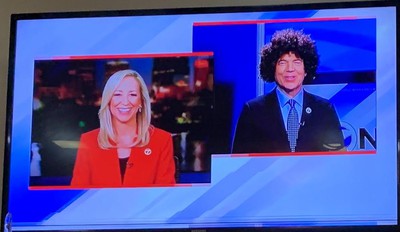October 4, 2021
-The Washington Post
Instead, the two White journalists wore Afro-like wigs.
“It was just bad judgment,” John Seabers, a Sinclair vice president and group manager, told The Washington Post. “It was a spoof on the ’70s that just went wrong.”
This is beyond disappointing @KATV. I talked to local journalists and members of the Black community traumatized by talent’s decision to wear afros on air. I am more concerned by an apparent culture that gives air to demeaning acts. This cannot continue. @nabj @NABJBroadcastTF pic.twitter.com/abzU4Phoke
— Ken Lemon (@kennabjvpbcast) September 19, 2021
Like KATV, newsrooms around the country are less diverse than the U.S. workforce as a whole and have been for decades, something journalism leaders have said they want to change. Pushes to diversify newsrooms have intensified in recent years, spurred in large part by the racial reckoning the country faced after Minneapolis police officer Derek Chauvin murdered George Floyd in May 2020.
“We apologize to all viewers who were rightfully offended by the segment and we promise to enact and enforce new measures to prevent future incidents from occurring,” Seabers wrote in a statement.
Seabers — who oversees Sinclair stations in Arkansas, Texas and Oklahoma — followed up by meeting with the Central Arkansas Association of Black Journalists. He was joined by Sinclair regional news director Blaise Labbe, who is taking over at KATV for the ousted Genty while the company hunts for a permanent replacement. Genty declined to comment when contacted by The Post; May and Brandt did not immediately respond to requests for comment.
During the meeting with the Black journalists, the Sinclair representatives offered no excuses and criticized what had happened, the Arkansas Times reported. Seabers called the wig segment “abhorrent” and “juvenile.” Labbe said it was “stupid,” adding that he was especially angry given that the KATV staff completed two racial-sensitivity training sessions in the six weeks preceding the wig segment.
“How in the hell could this happen?” he said at the meeting, according to the Times. Labbe acknowledged Sinclair has some critics after employees reported being ordered to air biased segments, according to the New Yorker, and being fed interview questions favoring Republicans.
KATV in particular, Seabers told The Post, recently responded to an employee’s report of a Mammy doll — a racist caricature of Black women — hanging in a cubicle shared by reporters and photographers.
The company investigated most of June but didn’t figure out who put the doll there or why. But, Seabers acknowledged, the doll was “racist and offensive.”
Because of the doll, managers in July made a formal presentation to all KATV employees, training them in inclusion and hidden bias, Seabers said.
The Afro incident brought further scrutiny to the news station. After the on-air display, Dorothy Tucker, president of the National Association of Black Journalists, noted the station employs more than 40 people, only eight of whom are Black. That’s less than 20 percent of staff in a city with a population that’s 42 percent Black. And, she told The Post, all the managers at KATV are White, something Seabers confirmed.
“We’re trying to encourage minorities to realize … that journalism is a career field for them,” he said.




